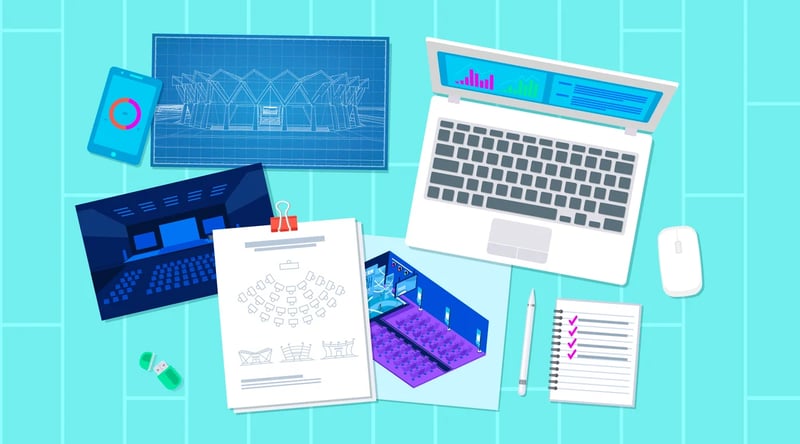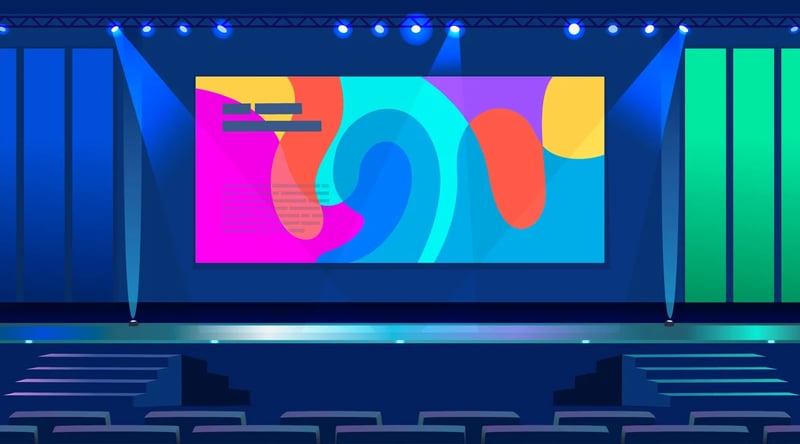You’ve already mapped out the big picture of your live event. You know what it’s for, where and when it’s happening, and how much money you plan to spend.
Now what?
The rest of the process is the fun part- deciding on all the little details!
Here are some of the most important details to focus on:
- Floor Plan
- Decor / Environment
- Agenda
- Setup and Technical Testing
- Rehearsal
- Last-minute Prep
- Walk-in
- Cleanup and Review
Floor Plan

Having a proper floor plan is important, because it tells you where all the people and equipment should go.
Getting this wrong can wreak havoc on your event. Imagine trying to fit too many people and too much AV into a small room!
When it comes to creating a floor plan, your options range from informal to highly precise:
- Basic sketches
- Scale drawings
- Seating and set plots
- 2D/3D renderings
A sketch, even pencil on paper, is always a great start. It provides a visual reference for everyone involved.
Basic scale drawings using tools like www.socialtables.com or www.smartdraw.com are used by venues and planning pros to layout the tables, chairs and AV. Using actual room and furniture dimensions ensures that everyone fits and can move around comfortably.
Production companies utilize tools like www.vectorworks.net to develop precise drawings and can include 2d/3d renderings and lighting pre-visualizations.
HB Live develops detailed seating and set plots depending on your requirements. These drawings provide a visual reference, so that we’re not all relying on our imagination and vague suggestions like “over there”!
Decor and Environment

The venue should be decorated to subtly (or overtly, if desired) suggest your brand to everyone participating. There should be enough information for everyone to “feel” like they are surrounded by your organization, without distracting from the main content of the event.
For example, it is appropriate to have your brand logo and relevant artwork decorating the environment. Keep the audience experience in mind. For corporate events, line of sight to the projection screens outweighs the need for tall, fancy centerpieces. A gala or fund-raiser has a different set of priorities and should be decorated accordingly.
Lighting is another major factor involved here. Functional lighting such as a stage wash or up-lighting ensures that the presenters can be seen clearly, both in-room and on video. Dressing up the event stage is a great way to represent your brand, and decorative and moving lights set the mood for fun and excitement!
Agenda
Your agenda, or run-of-show, is the exact schedule or itinerary for the live event. It will include a runtime and order for each thing that will happen.
Pay attention to small details such as openings, transitions, and closing. These take up time as well, and will affect the way your event runs. Watch for an in-depth blog article on Run-of-Show documentation soon!
Setup and Technical Testing

This is when all that planning starts to pay off. Depending on the size and complexity of the event, setup can take an entire day or more to complete. Careful collaboration between all teams like seating, AV, and decor allow for a smooth load-in and setup without crashing into each other. Compare the setup to the approved floor plan and discuss any desired changes with the team(s) as soon as you see something amiss.
As AV systems are connected, there will be plenty of testing including the sound, visuals like PowerPoint and video playback, lighting adjustments and more. Be prepared for these necessary tests, even though they feel like disruptions. This is also the time to connect any remote presenters and test your stream for remote viewers, if applicable.
Rehearsal
It’s always a good idea to have some kind of rehearsal before the event. Like everything with your event, this can take many forms, from very simple to highly complex events.
The simplest thing you can do is a basic 5-minute walk through. There’s no need to have each speaker practice their entire speech, or even be present. You just have to go through each step, miming them as if they were happening or simply stating what should happen.
On the other end of the scale, you can do a full dress rehearsal. This is essentially the live event in its entirety, without the audience. This path makes sense for most high profile events, or to appease a really nervous CEO.
For most events, you will probably rehearse with something in between. A light walkthrough, but with a little bit of actual demonstration of the content.
Last-minute Preparations and Welcome
Preparing an event occurs right until the very last second before the event starts. You can always double and triple check everything, but something will always change!
Your team of professionals is ready for these last minute adjustments, but do your very best to manage and minimize changes. Each change adds an element of risk, so don’t throw away all your preparation!
Once the doors open, the video stream is live and the audience enters the room, it’s time to focus on that experience and enjoy the work that made this all come together. It’s Show Time!
Cleanup and Review
The event isn’t over when the curtain falls. Equipment must be broken down and removed and the room restored to the pre-event conditions. Cleaning up is a way of showing basic courtesy to your venue, although much of the work may be performed by the venue staff.
After the event, you’ll want to review what happened and collect feedback. The former is how you and your vendors thought the event went. The latter is how your attendees report their experience.
There are many options that businesses have for eliciting feedback, ranging from paper reviews to on-line surveys. Use polling software like www.polleverywhere.com to collect feedback from your audience wherever they participated.
Meet with your venue and technical teams to discuss what went well and what should be improved for future events. You may learn that there were issues, but they were resolved before you or the attendees even noticed. You should always solicit suggestions, since perspectives will vary from team to team.
Conclusion
Bringing your event from vision to success is all about nailing the right details. You need to decide on the right floor plan, decor, agenda, and more. All the fun stuff!
But success is also about last minute checks and carefully reviewing feedback. No matter how much you do, there’s always room for improvement in event design and planning.
HB Live specializes in hybrid event production, and we strive to plan and produce them with the latest developments in mind.
Considering holding a hybrid event? We’d be happy to help!



